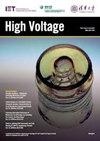改进的铝合金导体腐蚀预测模型:考虑电场和动态边界的影响
IF 4.9
2区 工程技术
Q1 ENGINEERING, ELECTRICAL & ELECTRONIC
引用次数: 0
摘要
高压输电导线的腐蚀问题通常发生在有电场的环境中。然而,目前的研究主要集中在金属的大气腐蚀上,对电场和大气条件对金属腐蚀的综合影响关注较少。本文建立了考虑电场和动态边界影响的腐蚀预测模型。由于动态边界的影响,该模型可以计算外加电场和不外加电场作用下金属样品的腐蚀速率、腐蚀深度、腐蚀产物积累和离子浓度等参数。通过室内低外加电场加速腐蚀试验和实际±500 kV输电线路高电场区铝合金导体试样对模型进行了验证。结果表明,随着时间的推移,铝合金的腐蚀速率先增大后减小。同时,在外加电场作用下,铝合金的腐蚀速率高于同期无电场作用下的腐蚀速率。分析了腐蚀速率增加的机理是电场的存在加速了电极的阴极反应速率。在较低的电场(0 ~ 20 kV/m)下,试样的腐蚀速率提高了约78%,在较高的电场(2000 kV/m左右)下,试样的腐蚀速率提高了约2.75倍。本文章由计算机程序翻译,如有差异,请以英文原文为准。
Improved Prediction Model for the Corrosion of Aluminium Alloy Conductors: Considering the Influence of Electric Field and Dynamic Boundary
The corrosion problems of high-voltage power transmission conductors typically occur in environments with electric fields. However, current research mainly focuses on atmospheric corrosion of metals with limited attention to the combined effects of electric fields and atmospheric conditions on metal corrosion. This study established a corrosion prediction model that considers the effects of electric fields and dynamic boundaries. Because of the influence of dynamic boundaries, this model can calculate parameters such as corrosion rate, corrosion depth, corrosion product accumulation and ion concentration for metal samples with and without an external electric field. The model is validated through indoor accelerated corrosion tests under low applied electric fields and by using aluminium alloy conductor samples from high electric field regions of actual ± 500 kV power transmission lines. The results indicate that the corrosion rate of aluminium alloys initially increases and then decreases over time. Additionally, the corrosion rate of aluminium alloys under an applied electric field is higher than that without an electric field during the same period. The mechanism of increased corrosion rate is analysed to be that the presence of the electric field accelerates the cathode reaction rate of the electrode. The corrosion rate of the sample increased by about 78% under a lower electric field (0–20 kV/m) and by about 2.75 times under a higher electric field around 2000 kV/m.
求助全文
通过发布文献求助,成功后即可免费获取论文全文。
去求助
来源期刊

High Voltage
Energy-Energy Engineering and Power Technology
CiteScore
9.60
自引率
27.30%
发文量
97
审稿时长
21 weeks
期刊介绍:
High Voltage aims to attract original research papers and review articles. The scope covers high-voltage power engineering and high voltage applications, including experimental, computational (including simulation and modelling) and theoretical studies, which include:
Electrical Insulation
● Outdoor, indoor, solid, liquid and gas insulation
● Transient voltages and overvoltage protection
● Nano-dielectrics and new insulation materials
● Condition monitoring and maintenance
Discharge and plasmas, pulsed power
● Electrical discharge, plasma generation and applications
● Interactions of plasma with surfaces
● Pulsed power science and technology
High-field effects
● Computation, measurements of Intensive Electromagnetic Field
● Electromagnetic compatibility
● Biomedical effects
● Environmental effects and protection
High Voltage Engineering
● Design problems, testing and measuring techniques
● Equipment development and asset management
● Smart Grid, live line working
● AC/DC power electronics
● UHV power transmission
Special Issues. Call for papers:
Interface Charging Phenomena for Dielectric Materials - https://digital-library.theiet.org/files/HVE_CFP_ICP.pdf
Emerging Materials For High Voltage Applications - https://digital-library.theiet.org/files/HVE_CFP_EMHVA.pdf
 求助内容:
求助内容: 应助结果提醒方式:
应助结果提醒方式:


